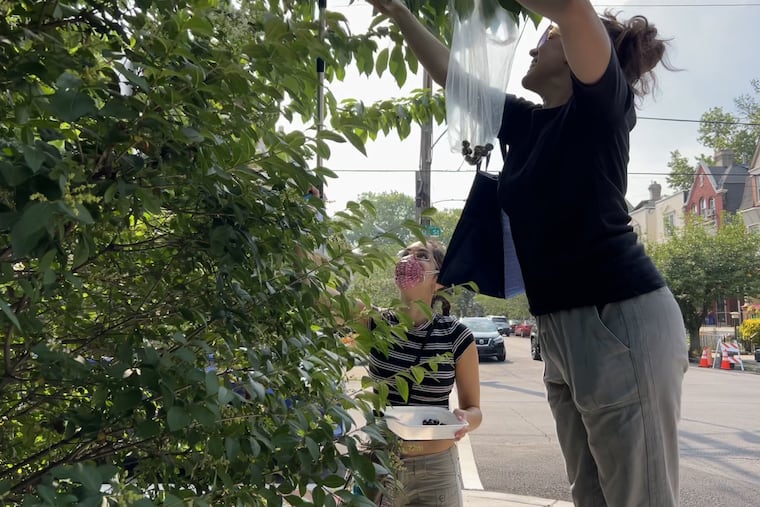Philadelphia’s fruit trees are blooming, but questions surround who gets the harvest
Philadelphia has a surprising bounty of fruit trees. Who has the right to their harvest?

The galette, a baked dessert stuffed with mulberries, juneberries, and rhubarb, was sweet and delicious, a perfect confection to accompany a summer afternoon spent lounging on a West Philadelphia porch.
“What you’re tasting is the crime,” explained the baker, Monica Fonorow.
She was joking, kind of.
In West Philly, a foraging culture thrives. Fonorow had pulled the mulberries and juneberries from trees and bushes in West Philadelphia, where trees also tempt with cherries, pawpaws, and figs. But whether to pluck the fruit is a complicated matter, one that touches on property rights and good manners.
Fonorow, who works in communications at University of Pennsylvania, wanted to know, where is it OK to pick fruit from trees and bushes? She asked through Curious Philly, The Inquirer’s forum for questions about the city and region.
Fonorow and another friend, Samia Bouzid, live in the neighborhood and recently ran afoul of a neighbor who wasn’t pleased to see them picking cherries from a tree in front of her house. The tree was planted between the sidewalk and the street. Fonorow said she won’t touch fruit growing on plants directly on a home’s property, but assumed fruit from trees in that median area are essentially available to the public.
“It always just seemed like part of the culture of the neighborhood,” Fonorow said.
Bouzid, who lives on Cedar Avenue near 47th Street, has a fig tree between the sidewalk and the street near her home, and neighbors feel comfortable helping themselves to its bounty.
“I just take any opportunity to take a walk and see what’s blooming,” said Bouzid, a freelance audio producer. “It just feels very neighborly.”
The city doesn’t have specific laws about picking fruit from trees along the street, but several sources, including the Parks and Recreation Department, said Fonorow and Bouzid at least broke etiquette by taking cherries without asking permission.
Trees between sidewalk and street do belong to the home they are in front of, according to Parks and Rec, but they are maintained by the department. Residents cannot plant, prune, or cut down those trees without consulting with the department.
The city does provide trees for residents to plant, but aside from juneberries, also known as serviceberries, orchard trees are more likely to have been planted by homeowners, said Erica Smith Fichman, the department’s community forestry manager. The city is reluctant to plant orchard trees because fruit that falls to the street can be a safety hazard and attract insects and other pests.
Both Fonorow and Bouzid have warm memories of their first foraging experiences. Bouzid said the first entry in her childhood journal was about picking blackberries in her neighborhood with her father. Enjoying the trees’ bounty is part of the communal mindset espoused by many in parts of Philadelphia. One Philadelphia writer, Ross Gay, even wrote a poem about it, To the Fig Tree on 9th and Christian.
Lynn Landes, founder of the Wild Foodies of Philadelphia, gives tours of areas with wild fruit, and described foraging as a way for city dwellers to realize the potential to feed themselves off the land.
“It’s really a yearning to know what you can do for yourself,” she said.
Fonorow described it as a way to be more present in her community.
“You have to be sort of paying attention and mindful and observant,” she said. “It feels like a reward for being that way.”
Phil Forsyth, co-executive director of the Philadelphia Orchard Project and a West Philadelphia resident, confirmed the orchard trees in the neighborhood were planted by residents, probably as recently as five to 10 years ago.
“It really is, in Philadelphia, the homeowner’s street tree,” he said. “It would be etiquette to ask. At the least, just pick a few.”
He acknowledged, though, that in practice many in the neighborhood are comfortable with people helping themselves to low-hanging fruit.
“I think it can create a sense of community for the block,” Forsyth said, “especially if it’s done with the consent of neighbors.”
During a recent foraging expedition with Fonorow and Bouzid, the cherry trees particularly beckoned. Some bore nearly black cherries, others a deep maroon. A few trees were heavy with cherries so red they look illuminated from within, glowing little orbs begging to be picked.
The women pulled cherries off a tree in a neighbor’s yard, this time with permission. The juice stained their hands purple as Fonorow’s plastic bag grew heavy with fruit.
“Walking around West Philly in the summer,” she said, “just everything looks appetizing.”